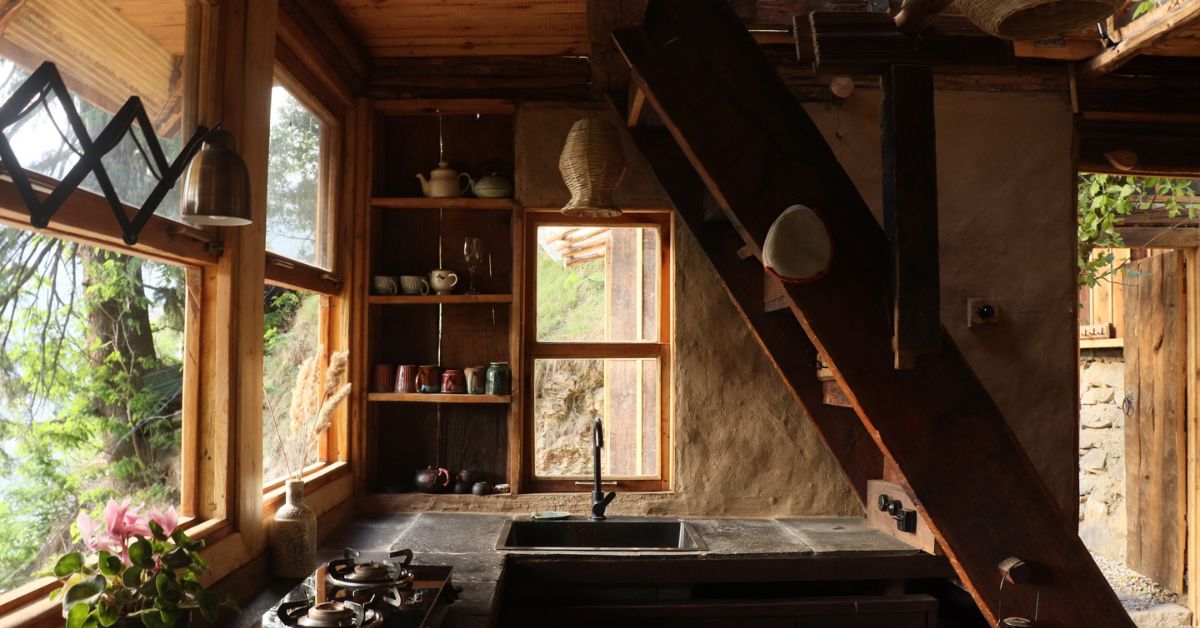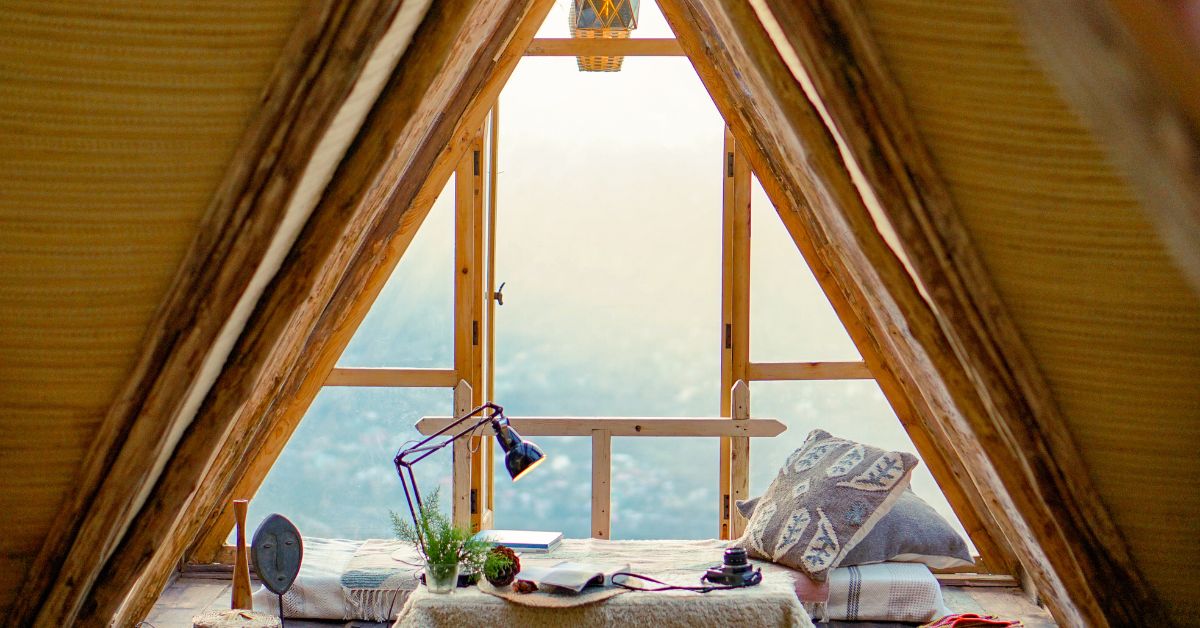Growing up in the beautiful city of Shimla, Rahul Bhushan, the founder of NORTH, a Himachal-based collective and homestay, disliked the rapid growth of modern architecture.
“Part of the reason was the rapid growth of the city, and part was the increase of tourism around these parts. I had always intended to return and do something to remind and highlight the vernacular architecture of the state,” Rahul Bhushan shares with The Better India.
Presently, he runs a collective that hosts artists’ residencies and acts as a regional centre that documents the architecture, way of life, regional culture and crafts of the region. The campus also doubles as a homestay which not only offers a peek into the beauty of the place but also the slow life of the area.
“We really wanted to have a holistic view of things and promote our culture and vernacular architecture while hosting people in our sustainable homestay,” he adds.
‘We are sharing a way of life here’
Nestled in the heart of Naggar, amid the Deodar trees, the views that the homestay offers is like a dream come true. A visual delight, the place overlooks the Beas River and the majestic Dhauladhar range.
However, the magnificent homestay overlooking these views started as a collective to save the heritage, culture and vernacular architecture of the area. So what led to the foundation of this homestay? Rahul explains.
“During my masters in architecture, I focused my research thesis on indigenous building practices in the western Himalayan region. I specifically looked at Kashmir and Himachal and documented the entire construction process.”
With that background, Rahul got the idea of using his knowledge for the holistic sustainable development of the Himalayan region.
He says, “There are so many buildings that can be restored and preserved. These buildings were built almost 100 years ago, some even 80 or 150 years ago. These buildings cannot be built again. There are so many traditional houses in local villages, and the Britishers also made a lot of different buildings in Himachal. Unfortunately, these buildings are now being abandoned or slowly going out of use.”

“The initial idea was to set up a centre in Himachal. This centre would not just be a regional centre, but a centre for innovation and research, documentation, and community activities. The focus would be on local systems, the way of living in the mountains, specifically the Kath Kuni architecture,” he says.
However, it was during the formation of these ideas that Rahul realised something.
“I realised that the right way to reach people and attract them here would be through tourism,” he says.
Tourism with a Purpose
Traditional tourism often involves telling people about a place. “At North Collective, we believe in a more immersive experience. Through tourism, visitors can experience our way of life firsthand,” he says.
This is how Rahul decided to start the NORTH homestay.
“Our campus allows visitors to connect with our team members, who share the wisdom passed down through generations. This cultural exchange fosters a sense of community for our guests.
We view tourism as a way to share the Himalayan way of life, built on responsible practices and a deep connection to nature. This experience can be transformative, promoting personal growth and a deeper appreciation for the region’s culture, crafts, and architecture,” he says.
Talking about the inspiration for North Collective, he shares, ‘The inspiration behind North Collective stems from two main concerns: climate change and the importance of living in balance with nature. I believe urgent action is needed to address climate issues, and that a simpler way of life can be a powerful example,” he says.
North Collective offers more than just beautiful accommodations.
“We curate experiences that connect visitors to the local community, such as heritage walks, honey-tasting workshops, and traditional craft demonstrations. We also source local ingredients for our meals, adding a contemporary touch to traditional dishes. Ultimately, North Collective is driven by a desire to preserve and promote our culture. We invite visitors to explore this rich heritage and rediscover the value of their own cultures,” he says.

The homestay and its unique features
“Our campus spans 1.2 acres, with approximately 60% of the land being wild, open green spaces. It is surrounded on three sides by the Deodar forest and includes an orchard. The centrepiece of our campus is the main Kath Kuni building, which houses our team, a community kitchen, and two rooms which double as homestay initially,” he says.
The place also has an open studio where their team conducts research and works on various architectural projects in Himachal.
“This studio is open to guests, who can explore our extensive archives and documentation of local villages, crafts, antiques, and architecture. It serves as a co-working space for visitors to engage with our team and resources.”
Staying at the property, Micheal Mario D’souza says that his experience was one of a kind. “It is a place where you get to know a unique culture and its craftsmanship. The founder and hosts are very passionate about their cause. The food is another highlight – it is homely and delicious. The best part? It is served in a room with stunning views.”
During the COVID-19 pandemic, Rahul and his team constructed a traditional wooden cabin on the property.
“This cabin, built using reclaimed wood from an old Kath Kuni house and filled with stone and plastered with mud, serves as a benchmark for sustainable construction. It challenges myths about the quality and affordability of mud houses, demonstrating that they can be cost-effective, quickly built, and equipped with modern amenities. This project exemplifies our commitment to sustainable and culturally-rich building practices.” he says.
The cabin is made with reclaimed wood, clay and mud. Additionally, the entire campus runs on the idea of no or low waste.
“We segregate our waste into wet and dry categories. The wet waste is composted in a pit we dug on the property. Occasionally, we give the wet waste to a neighbour who has cows, and in exchange, she provides us with cow dung. This barter system helps us obtain cow dung for our plants and for plastering new structures,” he shares.
Talking about the various activities that you can indulge in at the property, he says, “We emphasise the coexistence with local honey bees, reflecting the cultural wisdom where every house used to have honey bees. We offer honey-tasting experiences and share knowledge about bees and honey production. Our heritage walks take visitors to traditional villages, temples, and castles, where we share insights about the local architecture.”
They also host craft workshops where participants can learn wood carving, metal beating, handloom techniques, and clay modelling. “Our pottery area is another engaging spot. Our hospitality system is unique, allowing guests to immerse themselves in the local culture,” he notes.
“In terms of food, we teach guests how to prepare local dishes like siddu, ferra and local rajma. We have experiences such as sunset gatherings in a meadow on our property. Here, we serve local herbal teas made from dried rose petals, rhododendrons, and other varieties around a small bonfire,” he says.
“I feel that most would find this a very unique experience, not quite like a hotel, a homestay, or an eco-resort for everyone. It’s more like a small creative campus without your typical hospitality manager. Instead, we host everyone like family,” he shares.
Book your stay here.
(Edited by Padmashree Pande; All Images Credit: NORTH Collective)
No comments:
Post a Comment